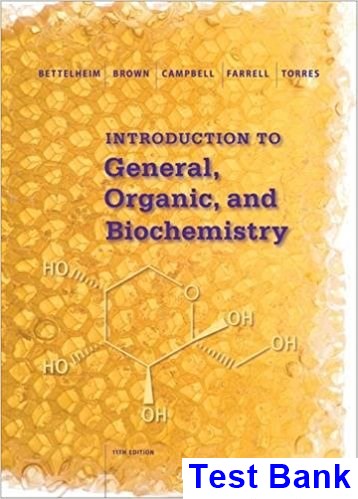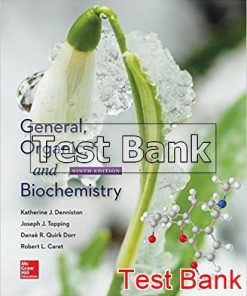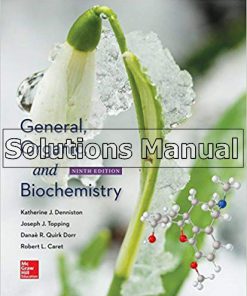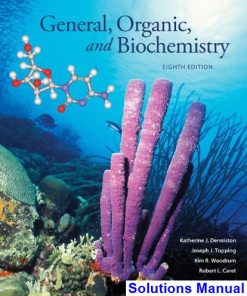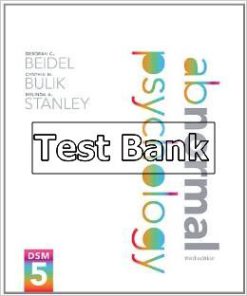Introduction to General Organic and Biochemistry 11th Edition Bettelheim Test Bank
$26.50$50.00 (-47%)
Introduction to General Organic and Biochemistry 11th Edition Bettelheim Test Bank.
You may also like
Introduction to General Organic and Biochemistry 11th Edition Bettelheim Test Bank

Product details:
- ISBN-10 : 1285869753
- ISBN-13 : 978-1285869759
- Author: Frederick Bettelheim
Gain a comprehensive understanding of chemistry and see how it relates to health science with INTRODUCTION TO GENERAL, ORGANIC, AND BIOCHEMISTRY. This bestseller features dynamic art, interesting examples, coverage of the latest issues, and a wide variety of medical and biological applications. As you explore topics such as botulin toxin as a cosmetic agent, implications for the use of antibiotics, the Atkins diet, and ultraviolet sunscreen, you will see how useful the study of chemistry is to so many aspects of your life. The book’s built-in integration with OWLv2 (Online Web-based Learning) turns your chemistry study time into active experiences that build your comprehension and bring concepts to life.
Table contents:
1 An Introduction to Chemistry 1
1.1 The Nature of Chemistry 2
1.2 A Scientific Approach to Problem Solving 3
1.3 The Particulate Nature of Matter 5
1.4 Classifying Matter 7
Review 9
Review Questions 10
Paired Exercises, Additional Exercises 11
Answers to Practice Exercises 12
2 Standards for Measurement 13
2.1 Scientific Notation 14
2.2 Measurement and Uncertainty 15
2.3 Significant Figures 16
2.4 Significant Figures in Calculations 18
2.5 The Metric System 21
2.6 Dimensional Analysis: A Problem-Solving Method 27
2.7 Measurement of Temperature 30 Chemistry in action Setting Standards 32
2.8 Density 34
Review 37
Review Questions 38
Paired Exercises 39
Additional Exercises 41
Challenge Exercises, Answers to Practice Exercises 43
3 Elements and Compounds 44
3.1 Elements 45
3.2 Introduction to the Periodic Table 49
3.3 Compounds and Formulas 52
Review 57
Review Questions 58
Paired Exercises 59
Additional Exercises 60
Challenge Exercises, Answers to Practice Exercises 61
4 Properties of Matter 62
4.1 Properties of Substances 63
4.2 Physical and Chemical Changes 65
4.3 Learning to Solve Problems 68
4.4 Energy 68
4.5 Heat: Quantitative Measurement 70
4.6 Energy in the Real World 72
Review 74
Review Questions 75
Paired Exercises 76
Additional Exercises 77
Challenge Exercises, Answers to Practice Exercises 78
Putting It Together Chapters 1–4 review 79
5 Early Atomic Theory and Structure 82
5.1 Dalton’s Model of the Atom 83
5.2 Electric Charge 84
5.3 Subatomic Parts of the Atom 85
5.4 The Nuclear Atom 87
5.5 Isotopes of the Elements 89
5.6 Atomic Mass 92
Review 93
Review Questions 94
Paired Exercises 95
Additional Exercises 96
Challenge Exercise, Answers to Practice Exercises 97
6 Nomenclature of Inorganic Compounds 98
6.1 Common and Systematic Names 99
6.2 Elements and Ions 100
6.3 Writing Formulas from Names of Ionic Compounds 103
6.4 Naming Binary Compounds 105
6.5 Naming Compounds Containing Polyatomic Ions 109
6.6 Acids 111
Review 114
Review Questions 115
Paired Exercises 116
Additional Exercises 117
Challenge Exercise, Answers to Practice Exercises 118
Putting It Together Chapters 5–6 review 119
7 Quantitative Composition of Compounds 121
7.1 The Mole 122
7.2 Molar Mass of Compounds 126
7.3 Percent Composition of Compounds 129
7.4 Calculating Empirical Formulas 133
7.5 Calculating the Molecular Formula from the Empirical Formula 135
Review 138
Review Questions, Paired Exercises 139
Additional Exercises 141
Challenge Exercises, Answers to Practice Exercises 142
8 Chemical Equations 143
8.1 The Chemical Equation 144
8.2 Writing and Balancing Chemical Equations 145
8.3 Types of Chemical Equations 150
8.4 Heat in Chemical Reactions 156
8.5 Global Warming: The Greenhouse Effect 159
Review 161
Review Questions, Paired Exercises 163
Additional Exercises 165
Challenge Exercise, Answers to Practice Exercises 166
9 Calculations from Chemical Equations 167
9.1 Introduction to Stoichiometry 168
9.2 Mole–Mole Calculations 170
9.3 Mole–Mass Calculations 173
9.4 Mass–Mass Calculations 174
9.5 Limiting Reactant and Yield Calculations 176
Review 182
Review Questions, Paired Exercises 183
Additional Exercises 185
Challenge Exercises, Answers to Practice Exercises 187
Putting It Together Chapters 7–9 review 188
10 Modern Atomic Theory and the Periodic Table 191
10.1 Electromagnetic Radiation 192
10.2 The Bohr Atom 193
10.3 Energy Levels of Electrons 195
10.4 Atomic Structures of the First 18 Elements 198
10.5 Electron Structures and the Periodic Table 201
Review 206
Review Questions 207
Paired Exercises 208
Additional Exercises 210
Challenge Exercises, Answers to Practice Exercises 211
11 Chemical Bonds: The Formation of Compounds from Atoms 212
11.1 Periodic Trends in Atomic Properties 213
11.2 Lewis Structures of Atoms 216
11.3 The Ionic Bond: Transfer of Electrons from One Atom to Another 217
11.4 Predicting Formulas of Ionic Compounds 222
11.5 The Covalent Bond: Sharing Electrons 224
11.6 Electronegativity 226
11.7 Lewis Structures of Compounds 229
11.8 Complex Lewis Structures 232
11.9 Compounds Containing Polyatomic Ions 234
11.10 Molecular Shape 235
Review 239
Review Questions 240
Paired Exercises 241
Additional Exercises 243
Challenge Exercises 244
Answers to Practice Exercises 245
Putting It Together Chapters 10–11 review 246
12 The Gaseous State of Matter 248
12.1 Properties of Gases 249
12.2 Boyle’s Law 252
12.3 Charles’ Law 256
12.4 Avogadro’s Law 259
12.5 Combined Gas Laws 260
12.6 Ideal Gas Law 264
12.7 Dalton’s Law of Partial Pressures 267
12.8 Density of Gases 270
12.9 Gas Stoichiometry 270
Review 274
Review Questions 276
Paired Exercises 277
Additional Exercises 279
Challenge Exercises, Answers to Practice Exercises 281
13 Liquids 282
13.1 States of Matter: A Review 283
13.2 Properties of Liquids 283
13.3 Boiling Point and Melting Point 286
13.4 Changes of State 288
13.5 Intermolecular Forces 290
13.6 Hydrates 295
13.7 Water, a Unique Liquid 297
Review 300
Review Questions 301
Paired Exercises 302
Additional Exercises 303
Challenge Exercises, Answers to Practice Exercises 304
14 Solutions 305
14.1 General Properties of Solutions 306
14.2 Solubility 307
14.3 Rate of Dissolving Solids 311
14.4 Concentration of Solutions 312
14.5 Colligative Properties of Solutions 320
14.6 Osmosis and Osmotic Pressure 325
Review 326
Review Questions 328
Paired Exercises 329
Additional Exercises 332
Challenge Exercises, Answers to Practice Exercises 333
Putting It Together Chapters 12–14 review 334
15 Acids, Bases, and Salts 337
15.1 Acids and Bases 338
15.2 Reactions of Acids and Bases 342
15.3 Salts 343
15.4 Electrolytes and Nonelectrolytes 344
15.5 Introduction to pH 349
15.6 Neutralization 352
15.7 Writing Net Ionic Equations 354
15.8 Acid Rain 356
Review 357
Review Questions, Paired Exercises 359
Additional Exercises 361
Challenge Exercises, Answers to Practice Exercises 362
16 Chemical Equilibrium 363
16.1 Rates of Reaction 364
16.2 Chemical Equilibrium 365
16.3 Le Châtelier’s Principle 366
16.4 Equilibrium Constants 373
16.5 Ion Product Constant for Water 374
16.6 Ionization Constants 376
16.7 Solubility Product Constant 378
16.8 Buffer Solutions: The Control of pH 381
Review 383
Review Questions 384
Paired Exercises 385
Additional Exercises 387
Challenge Exercises, Answers to Practice Exercises 389
17 Oxidation–Reduction 390
17.1 Oxidation Number 391
17.2 Balancing Oxidation–Reduction Equations 395
17.3 Balancing Ionic Redox Equations 398
17.4 Activity Series of Metals 401
17.5 Electrolytic and Voltaic Cells 403
Review 407
Review Questions 409
Paired Exercises 410
Additional Exercises 412
Challenge Exercises, Answers to Practice Exercises 413
Putting It Together Chapters 15–17 review 414
18 Nuclear Chemistry 417
18.1 Discovery of Radioactivity 418
18.2 Alpha Particles, Beta Particles, and Gamma Rays 421
18.3 Radioactive Disintegration Series 424
18.4 Measurement of Radioactivity 426
18.5 Nuclear Energy 427
18.6 Mass–Energy Relationship in Nuclear Reactions 433
18.7 Biological Effects of Radiation 434
Review 436
Review Questions 437
Paired Exercises 438
Additional Exercises 439
Challenge Exercises, Answers to Practice Exercises 440
Putting It Together Chapter 18 review 441
19 Organic Chemistry: Saturated Hydrocarbons 443
19.1 Organic Chemistry: History and Scope 444
19.2 The Carbon Atom: Bonding, Shape, and Hybridization 445
19.3 Classifying Organic Compounds 447
19.4 Hydrocarbons 449
19.5 Saturated Hydrocarbons: Alkanes 450
19.6 Structural Formulas 451
19.7 Isomerism 453
19.8 Naming Organic Compounds 456
19.9 Introduction to the Reactions of Carbon 461
19.10 Reactions of Alkanes 463
19.11 Cycloalkanes 468
19.12 Gasoline: A Major Petroleum Product 471
Review 473
Review Questions, Paired Exercises 475
Additional Exercises 478
Challenge Exercise, Answers to Practice Exercises 479
20 Unsaturated and Aromatic Hydrocarbons 481
20.1 Bonding in Unsaturated Hydrocarbons 482
20.2 Nomenclature of Alkenes 484
20.3 Geometric Isomerism in Alkenes 487
20.4 Cycloalkenes 492
20.5 Preparation and Properties of Alkenes 493
20.6 Nomenclature and Properties of Alkynes 499
20.7 Aromatic Hydrocarbons: Structure of Benzene 501
20.8 Naming Aromatic Compounds 503
20.9 Polycyclic Aromatic Compounds 508
20.10 Sources and Properties of Aromatic Hydrocarbons 510
Review 513
Review Questions 514
Paired Exercises 515
Additional Exercises, Challenge Exercises 518
Answers to Practice Exercises 519
21 Polymers: Macromolecules 520
21.1 Macromolecules 521
21.2 Synthetic Polymers 521
21.3 Polymer Types 522
21.4 Addition Polymerization 523
21.5 Recycling Plastics 525
21.6 Butadiene Polymers 527
21.7 Geometric Isomerism in Polymers 529
Review 530
Review Questions, Paired Exercises 531
Additional Exercises, Challenge Exercise, Answers to Practice Exercises 532
Putting It Together Chapters 19–21 review 533
22 Alcohols, Ethers, Phenols, and Thiols 537
22.1 Structure and Classification of Alcohols 538
22.2 Naming Alcohols 540
22.3 Physical Properties of Alcohols 542
22.4 Chemical Properties of Alcohols 544
22.5 Common Alcohols 551
22.6 Phenols 554
22.7 Properties and Preparation of Phenols 557
22.8 Ethers 558
22.9 Properties and Preparation of Ethers 561
22.10 Thiols 563
Review 564
Review Questions, Paired Exercises 566
Additional Exercises, Challenge Exercises 570
Answers to Practice Exercises 571
23 Aldehydes and Ketones 572
23.1 Structures of Aldehydes and Ketones 573
23.2 Naming Aldehydes and Ketones 573
23.3 Bonding and Physical Properties 577
23.4 Chemical Properties of Aldehydes and Ketones 580
23.5 Common Aldehydes and Ketones 588
23.6 Condensation Polymers 590
Review 591
Review Questions 592
Paired Exercises 593
Additional Exercises 595
Challenge Exercise 596
Answers to Practice Exercises 597
Putting It Together Chapters 22–23 review 598
24 Carboxylic Acids and Esters 603
24.1 Carboxylic Acids: Nomenclature and Sources of Aliphatic Carboxylic Acids 604
24.2 Physical Properties of Carboxylic Acids 607
24.3 Classification of Carboxylic Acids 609
24.4 Preparation and Chemical Properties of Carboxylic Acids 613
24.5 Nomenclature of Esters 618
24.6 Occurrence and Physical Properties of Esters 621
24.7 Polyesters: Condensation Polymers 621
24.8 Chemical Properties of Esters 622
24.9 Glycerol Esters 624
24.10 Soaps and Synthetic Detergents 627
24.11 Esters and Anhydrides of Phosphoric Acid 631
Review 632
Review Questions, Paired Exercises 635
Additional Exercises 638
Challenge Exercises 639
Answers to Practice Exercises 640
25 Amides and Amines: Organic Nitrogen Compounds 641
25.1 Amides: Nomenclature and Physical Properties 642
25.2 Chemical Properties of Amides 646
25.3 Polyamides: Condensation Polymers 647
25.4 Urea 648
25.5 Amines: Nomenclature and Physical Properties 648
25.6 Preparation of Amines 653
25.7 Chemical Properties of Amines 654
25.8 Sources and Uses of Selected Amines 657
Review 660
Review Questions 661
Paired Exercises 662
Additional Exercises 664
Challenge Exercise, Answers to Practice Exercises 665
Putting It Together Chapters 24–25 review 666
26 Stereoisomerism 671
26.1 Review of Isomerism 672
26.2 Plane-Polarized Light and Optical Activity 672
26.3 Fischer Projection Formulas 675
26.4 Enantiomers 677
26.5 Racemic Mixtures 682
26.6 Diastereomers and Meso Compounds 684
Review 687
Review Questions, Paired Exercises 688
Additional Exercises 691
Challenge Exercise, Answers to Practice Exercises 692
27 Carbohydrates 694
27.1 Carbohydrates: A First Class of Biochemicals 695
27.2 Classification of Carbohydrates 696
27.3 Importance of Carbohydrates for Life 698
27.4 Common Monosaccharides 699
27.5 Structure of Glucose and Other Aldoses 700
27.6 Cyclic Structures of Common Hexoses 704
27.7 Hemiacetals and Acetals 708
27.8 Pentoses 709
27.9 Structures and Properties of Disaccharides 710
27.10 Sweeteners and Diet 713
27.11 Redox Reactions of Monosaccharides 715
27.12 Polysaccharides 719
Review 724
Review Questions, Paired Exercises 727
Additional Exercises, Challenge Exercises 729
Answers to Practice Exercises 730
28 Lipids 731
28.1 Lipid Characteristics and Classification 732
28.2 Simple Lipids 733
28.3 Fats in Metabolism 738
28.4 Compound Lipids 739
28.5 Steroids 743
28.6 Hydrophobic Lipids and Biology 744
Review 750
Review Questions 751
Paired Exercises 752
Additional Exercises, Challenge Exercise, Answers to Practice Exercises 753
Putting It Together Chapters 26–28 review 754
29 Amino Acids, Polypeptides, and Proteins 759
29.1 The Structure–Function Connection 760
29.2 The Nature of Amino Acids 760
29.3 Formation of Polypeptides 766
29.4 Protein Structure 770
29.5 Protein Functions 773
29.6 Some Examples of Proteins and Their Structures 775
29.7 Loss of Protein Structure 783
29.8 Tests for Proteins and Amino Acids 784
29.9 Determination of the Primary Structure of Polypeptides 787
Review 789
Review Questions, Paired Exercises 792
Additional Exercises 794
Challenge Exercise, Answers to Practice Exercises 795
30 Enzymes 796
30.1 Molecular Accelerators 797
30.2 Rates of Chemical Reactions 798
30.3 Enzyme Kinetics 801
30.4 Industrial-Strength Enzymes 803
30.5 Enzyme Active Site 805
30.6 Temperature and pH Effects on Enzyme Catalysis 808
30.7 Enzyme Regulation 809
Review 811
Review Questions 812
Paired Exercises 813
Additional Exercises, Challenge Exercise, Answers to Practice Exercises 814
31 Nucleic Acids and Heredity 815
31.1 Molecules of Heredity—Bases and Nucleosides 816
31.2 Nucleotides: Phosphate Esters 819
31.3 High-Energy Nucleotides 820
31.4 Polynucleotides; Nucleic Acids 822
31.5 Structure of DNA 823
31.6 DNA Replication 827
31.7 RNA: Genetic Transcription 833
31.8 The Genetic Code—Genes and Medicine 836
31.9 Biosynthesis of Proteins 839
31.10 Changing the Genome: Mutations and Genetic Engineering 840
Review 844
Review Questions 846
Paired Exercises 847
Additional Exercises, Challenge Exercise, Answers to Practice Exercises 848
Putting It Together Chapters 29–31 review 850
32 Nutrition 854
32.1 Nutrients and Diet 855
32.2 Energy in the Diet 857
32.3 Macronutrients 858
32.4 Vitamins, Vital Micronutrients 861
32.5 Minerals 863
32.6 Water 864
32.7 Nutrition Content Labeling 864
32.8 Food Additives 866
32.9 A Balanced Diet 868
32.10 Human Digestion 870
Review 873
Review Questions, Paired Exercises 875
Additional Exercises 876
Challenge Exercise, Answers to Practice Exercises 877
33 Bioenergetics 878
33.1 Metabolism and Cell Structure 879
33.2 Biological Oxidation–Reduction: An Important Energy Source 880
33.3 Molecular Oxygen and Metabolism 884
33.4 High-Energy Phosphate Bonds 885
33.5 Phosphorylation: Energy Transfer 886
33.6 ATP Use and Muscle Contraction 889
33.7 Photosynthesis 892
Review 893
Review Questions 894
Paired Exercises 895
Additional Exercises, Challenge Exercises, Answers to Practice Exercises 896
34 Carbohydrate Metabolism 897
34.1 Metabolic Pathways, Carbohydrates, and Cooperation 898
34.2 Anaerobic Sequence 903
34.3 Citric Acid Cycle (Aerobic Sequence) 907
34.4 Gluconeogenesis 910
34.5 Overview of Complex Metabolic Pathways 910
34.6 Hormones 912
34.7 Blood Glucose and Hormones 913
Review 915
Review Questions, Paired Exercises 917
Additional Exercises 918
Challenge Exercise, Answers to Practice Exercises 919
35 Metabolism of Lipids and Proteins 920
35.1 Metabolic Energy Sources: Organs Working Together for the Common Good 921
35.2 Fatty Acid Oxidation (Beta Oxidation) 922
35.3 Fat Storage and Biosynthesis (Lipogenesis) 926
35.4 Ketone Bodies 928
35.5 Metabolic Nitrogen Fixation 929
35.6 Amino Acids and Metabolic Nitrogen Balance 931
35.7 Amino Acids and Nitrogen Transfer 932
35.8 Nitrogen Excretion and the Urea Cycle 934
35.9 Acetyl-CoA, Central Molecule in Metabolism 936
Review 938
Review Questions, Paired Exercises 940
Additional Exercises, Challenge Exercise 941
Answers to Practice Exercises 942
Putting It Together Chapters 32–35 review 943
Appendices
I. Mathematical Review A-1
II. Using a Scientific Calculator A-10
III. Units of Measurement A-14
IV. Vapor Pressure of Water at Various Temperatures A-15
V. Solubility Table A-16
VI. Answers to Selected Exercises A-17
VII. Answers to Putting It Together Review Exercises A-48
Glossary G-1
Index I-1
People also search:
Introduction to General Organic and Biochemistry 11th
Introduction to General Organic and Biochemistry 11th pdf
Introduction to General Organic and Biochemistry 11th download scribd
Introduction to General Organic and Biochemistry 11th quizlet
Introduction to General Organic and Biochemistry 11th key answers

